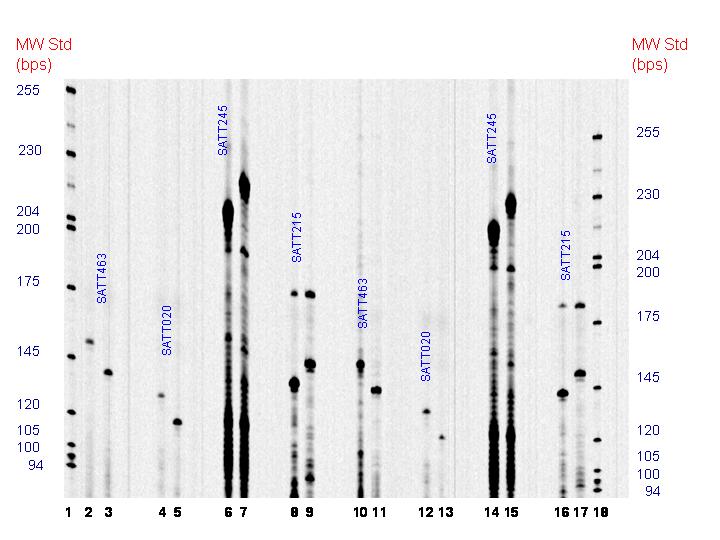Tsuru
| Denomination: | 'Tsuru' |
|---|---|
| Botanical Name: | Glycine max |
| Applicant/Holder: |
Agriculture & Agri-Food Canada, Harrow Greenhouse & Processing Crops Research Centre 2585 County Road 20 Harrow, Ontario N0R 1G0 Canada |
| Breeder: |
Vaino Poysa, Agriculture & Agri-Food Canada, Harrow, Ontario |
| Agent in Canada: |
Agriculture & Agri-Food Canada Office of Intellectual Property and Commercialization 107 Science Place Saskatoon, Saskatchewan S7N 0X2 Canada Tel: (306) 203-1383 |
| Application Date: | 2005-05-12 |
| Application Number: | 05-4890 |
| Grant of Rights Date: | 2007-11-16 |
| Certificate Number: | 2986 |
| Date rights surrendered: | 2012-03-26 |
Variety Description
Variety used for comparison: 'Harovinton'
Summary: 'Tsuru' is a tofu type soybean variety that flowers and matures later than 'Harovinton'. 'Tsuru' has lower protein content than 'Harovinton'.
Description:
PLANT: intermediate growth type, erect, grey hair on stem
HYPOCOTYL: strong anthocyanin
LEAF: medium to dark green, pointed ovate lateral leaflet
FLOWER: purple
MATURITY: group 2, 3100 heat unit rating
POD: tan
SEED: spherical flattened in shape, large, dull, yellow testa
HILUM: yellow, small
AGRONOMIC TRAITS: good resistance to shattering, good resistance to lodging
QUALITY CHARACTERISTICS: tofu type
CHEMICAL CHARACTERISTICS: high seed coat peroxidase activity
Origin & Breeding History: The tofu-style soybean variety 'Tsuru' was developed at the Greenhouse and Processing Crops Research Centre of Agriculture and Agri-Food Canada in Harrow, Ontario. It is derived from the cross OX232/ 'Harovinton' performed in 1996. Single plants were selected from the F4 in 1998 based on maturity, lodging resistance, yield potential, disease resistance and seed size. Selection between seedlots from individual threshed plants was for seed size, colour, seed coat integrity, SMV resistance, roundness and general appearance. Seed from individual F4 plants was grown in Harrow in 1998 and a line was selected based on yield, maturity, lodging resistance plant height, seed size, and oil, protein and sugar content of the seed. This line was tested in yield trials in 2000, 2001, 2002, 2003 and 2004. Selection criteria were high yield, acceptable maturity, high protein, large seed size, seed colour and appearance. Breeder seed of 'Tsuru' was produced by bulking seed of 23 F8 plant rows.
Tests & Trials: Trials for 'Tsuru' were conducted in 2005 and 2006 at The Honourable Eugene F. Whelan Experimental Farm in Woodslee, Ontario. Three replicate plots of the candidate and reference variety were planted in the first year of trial, and four replicate plots were planted in the second year. The plots were seeded at a minimum rate of 550 plants per plot, were 4 metres long and consisted of at least five rows with 46 cm spacing between rows. Measured characteristics were based on measurements taken from 20 plants. Simple sequence repeats (SSR) markers were tested on DNA from 'Tsuru' and 'Harovinton' as described in Song et al. (2004).
Reference:
Song QJ, Marek LF, ShoemakerRC, Lark KG, Concibido VC, Delannay X, Specht JE, Cregan PB (2004) A new integrated genetic linkage map of the soybean. Theor. Appl. Genet 109: 122-128
Comparison tables for 'Tsuru' with reference variety 'Harovinton'
Days to flowering
| 'Tsuru' | 'Harovinton' | |
|---|---|---|
| Year 1 | 45.0±1.0 | 42.7±0.5 |
| Year 2 | 43.3±0.6 | 40.6±0.6 |
Days to maturity
| 'Tsuru' | 'Harovinton' | |
|---|---|---|
| Year 1 | 114.0±3.5 | 111.7±2.5 |
| Year 2 | 113±0.8 | 109.5±0.6 |
Allele size (bp)
| 'Tsuru' | 'Harovinton' | |
|---|---|---|
| SATT463 | 140 | 152 |
| SATT020 | 118 | 129 |
| SATT245 | 223 | 210 |
| SATT215 | 148 | 138 |
Click on image for larger view

Soybean: PCR amplification patterns of DNA from candidate variety 'Tsuru' (lanes 3, 5, 7, 9, 11, 13, 15 and 17 ), and reference variety 'Harovinton' (lanes 2, 4, 6, 8, 10, 12, 14 and 16) with primers for SSR markers SATT463 (lanes 2, 3, 10 and 11), SATT020 (lanes 4, 5, 12 and 13), SATT245 (lanes 6, 7, 14 and 15) and SATT215 (lanes 8, 9, 16 and 17). Lanes 1 and 18 are molecular weight standards.
- Date modified: